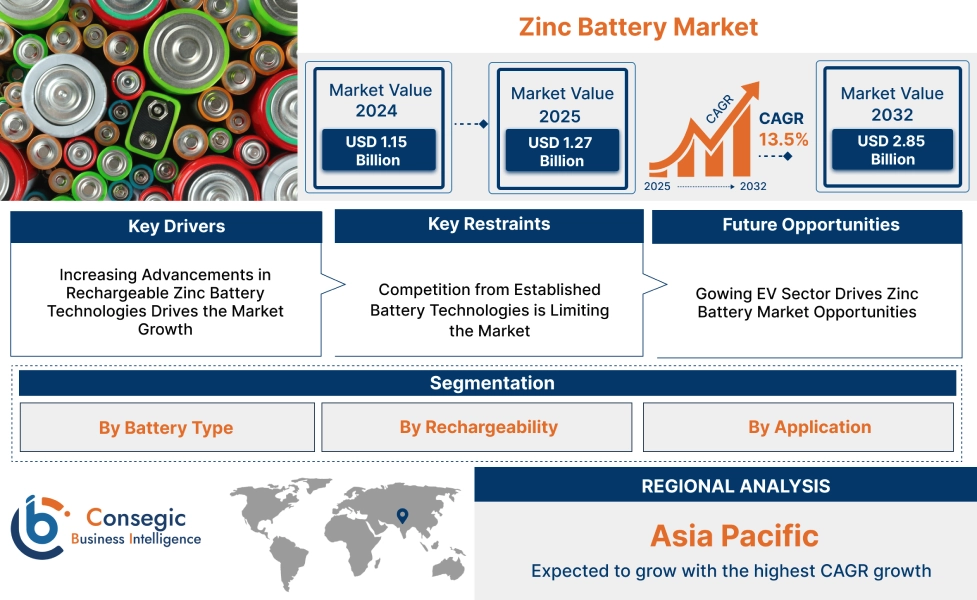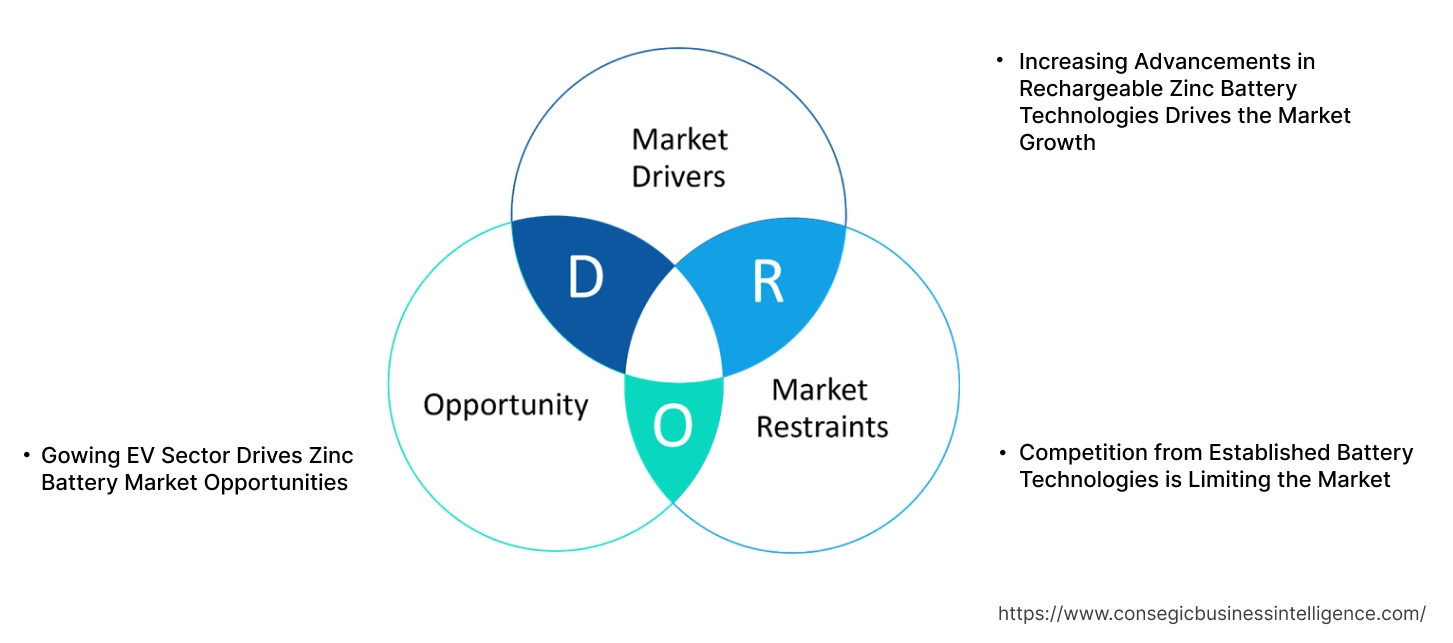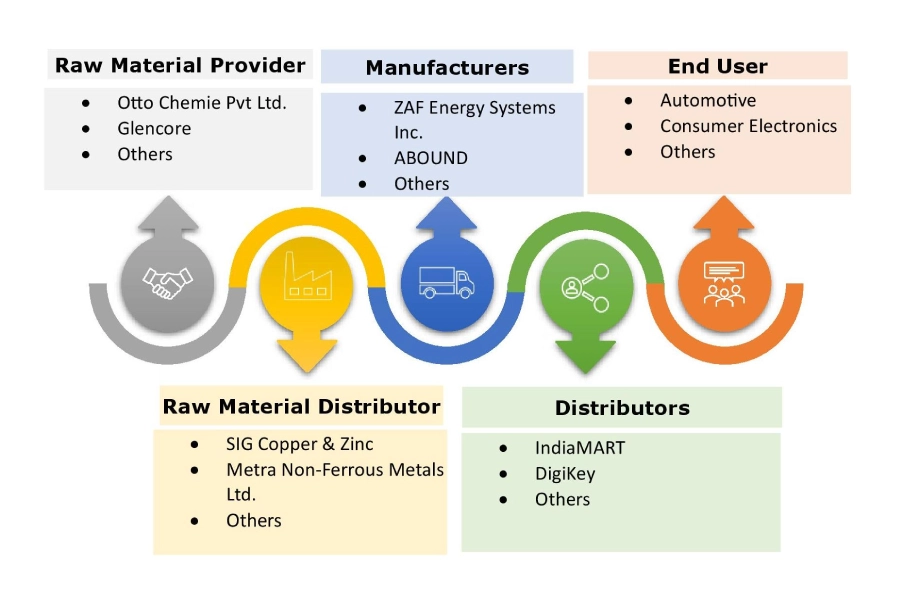Zinc Battery Market Size:
Zinc Battery Market is estimated to reach over USD 2.85 Billion by 2032 from a value of USD 1.15 Billion in 2024 and is projected to grow by USD 1.27 Billion in 2025, growing at a CAGR of 13.5% from 2025 to 2032.
Zinc Battery Market Scope & Overview:
Zinc batteries are a category of electrochemical energy storage devices that utilize zinc as a primary component, typically serving as the anode. They generate electricity through chemical reactions involving zinc. The advantages such as cost-effectiveness, abundance of raw materials, and inherent safety compared to some other battery chemistries are driving the market. The key trends including increasing demand for sustainable and cost-effective energy storage solutions, growing adoption of electric vehicles, and significant advancements in rechargeable zinc battery technologies like zinc-ion and nickel-zinc are driving the market.
How is AI Transforming the Zinc Battery Market?
Artificial Intelligence (AI) is rapidly transforming the zinc battery market across several key areas. Firstly, AI accelerates the discovery of new materials and chemistries for zinc batteries. Machine learning algorithms can analyze vast datasets to identify optimal electrode compositions and electrolyte formulations, drastically reducing the time and cost associated with traditional R&D. Secondly, AI optimizes manufacturing processes by enabling real-time monitoring, defect detection, and predictive maintenance. AI-driven systems can analyze production parameters to improve consistency, reduce waste, and enhance overall battery quality at scale. Finally, AI enhances Battery Management Systems (BMS) by allowing for more precise control over charging and discharging cycles, thermal management, and accurate lifespan prediction, ultimately extending battery life and improving performance in real-world applications, especially critical for grid storage and industrial uses.
Zinc Battery Market Dynamics - (DRO) :
Key Drivers:
Increasing Advancements in Rechargeable Zinc Battery Technologies Drives the Market Growth
Increasing advancements in rechargeable zinc battery technologies are profoundly driving market growth by overcoming performance limitations. There are significant breakthroughs in materials science, particularly the development of stable aqueous electrolytes and innovative electrode designs, which are effectively mitigating long-standing issues like dendrite formation and improving cycle life. Further, advancements enhance the overall efficiency, reliability, and power density of zinc-ion and nickel-zinc batteries. Moreover, the improved capabilities are positioning zinc batteries as increasingly viable and attractive alternatives for high-growth sectors such as large-scale grid energy storage, industrial backup power, and even specific segments within electric vehicles.
- For instance, International Zinc Association (IZA) launched the Zinc Battery Initiative (ZBI) in 2020 to promote rechargeable zinc batteries. The initiative's goal is to increase awareness and adoption of these batteries, highlighting their high performance, safety, and environmental benefits.
Thus, technological advancements and increasing adoption play a significant role om driving the zinc battery market size.
Key Restraints:
Competition from Established Battery Technologies is Limiting the Market
There is significant competition from established battery technologies which limits the market penetration and growth of zinc batteries. Lithium-ion batteries, with their high energy density and mature supply chains, currently dominate high-performance applications like electric vehicles and consumer electronics. Similarly, lead-acid batteries, despite their lower energy density, retain a substantial market share in cost-sensitive sectors such as automotive starting-lighting-ignition and certain backup power systems. Thus, based on aforementioned factors, the market is experiencing significant hurdles.
Future Opportunities :
Gowing EV Sector Drives Zinc Battery Market Opportunities
The growing electric vehicle sector presents significant opportunities for the zinc battery market by creating an increasing need for safer, more sustainable, and affordable battery chemistries. As the global push for decarbonization intensifies, zinc-based batteries, particularly advanced zinc-ion and zinc-air variants, are being actively explored as compelling alternatives to dominant lithium-ion chemistries. Further, their inherent safety, abundance of raw materials, and lower manufacturing costs make them attractive for specialized EV applications like light commercial vehicles and two-wheelers, and range extenders.
- For instance, according to IEA,in 2023, electric car sales in Europe increased by almost 20% compared to 2022, rising from 2.7 million to nearly 3.2 million units,. This growth in sales is driving the market globally.
Thus, environmental trends and focus on decarbonization drive EV sector which in turn drives zinc battery market opportunities.
Zinc Battery Market Segmental Analysis :
By Battery Type:
Based on the battery type, the market is segmented into zinc-carbon batteries, zinc-air batteries, nickel-zinc batteries, zinc-ion batteries, zinc-chloride batteries, alkaline zinc batteries, and others.
Trends in the Battery Type:
- High energy density and low cost make zinc-air batteries highly promising for grid-scale energy which in turn drives the zinc battery market trends.
- Increasing research is being conducted on solid-state electrolytes for zinc batteries to enhance safety, energy density, and cycle life which is expected to drive zinc battery market size.
Zinc-air batteries accounted for the largest revenue share of 39.82% in the year 2024.
- Increasing focus is on developing truly rechargeable zinc-air batteries to overcome their traditional limitation as single-use (primary) cells is driving the zinc battery market share.
- Further, companies are exploring their use in large-scale energy storage for the electric grid, backup power systems, and electric vehicles.
- Furthermore, innovation is centered on developing better materials for all components of the battery which drives the zinc battery market trends.
- Thus, as per analysis, improved rechargeability,diverse applications, and advanced materials are driving the market.
Nickel-zinc batteries is anticipated to register the fastest CAGR during the forecast period.
- Ni-Zn batteries are being increasingly used in uninterruptible power supply systems for data centers, telecommunication networks, and industrial facilities.
- Further, growing environmental regulations propels the zinc battery market expansion.
- Furthermore, Ni-Zn batteries are being integrated into hybrid energy storage solutions, often paired with lithium-ion or lead-acid batteries, to optimize cost, safety, and performance for diverse applications.
- Therefore, based on analysis, aforementioned trends are anticipated to boost the market during the forecast period.
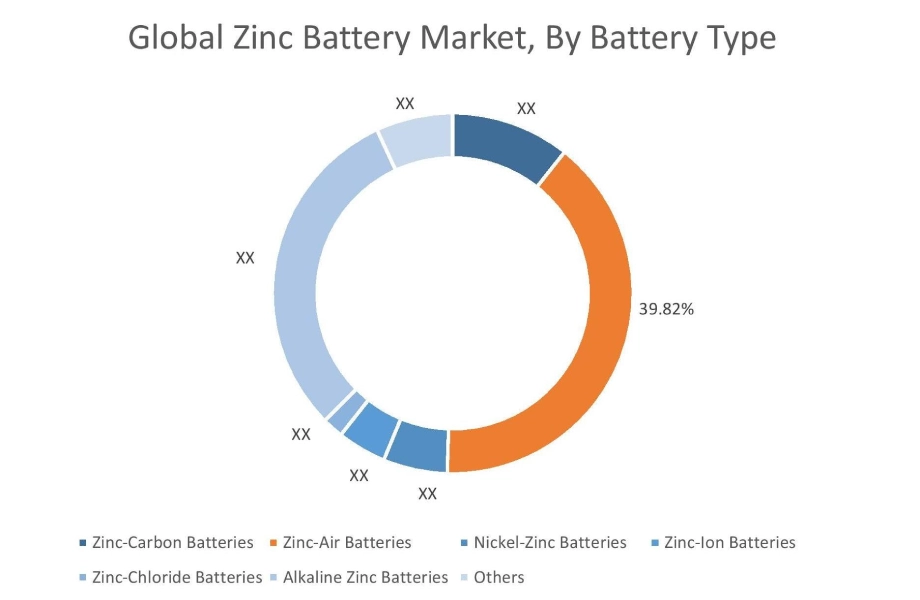
By Rechargeability:
Based on the rechargeability, the market is segmented into primary batteries and secondary batteries.
Trends in the Rechargeability:
- The major trend in high-speed zinc batteries is the continuous advancement of non-impact printing technologies to achieve even faster printing speeds and higher throughput which in turn drives the zinc battery market demand.
- Low-speed zinc batteries offer more compact designs and lower initial purchase costs in turn driving the zinc battery market share.
Primary Batteries for the largest revenue share in the year 2024.
- Primary batteries remain the preferred choice for a vast array of low-drain, everyday consumer electronics like remote controls, wall clocks, and toys.
- Further, manufacturers are continuously improving the design and chemistry of primary batteries to deliver higher energy density which in turn drives the zinc battery industry.
- Thus, as per zinc battery market analysis, enhanced performance anddominance in low-drain consumer devices are driving the market.
Secondary batteries is anticipated to register the fastest CAGR during the forecast period.
- Increasing research and development on improving the energy density, power output, and cycle life of zinc-ion batteries.
- Further, rechargeable zinc-based batteries, especially zinc-air and zinc-ion, are being heavily developed and deployed for large-scale energy storage systems which in turn propels the zinc battery market expansion.
- Furthermore, the high volumes of labels and documents required in retail and logistics necessitate cost-effective printing solutions which in turn drive the market.
- Therefore, based on analysis, aforementioned factors are anticipated to boost the market during the forecast period.
By Application:
Based on the application, the market is segmented into consumer electronics, medical devices, utilities/energy storage systems, automotive & transportation, industrial, military and defense, and others.
Trends in the Application:
- There's a growing need for reliable battery solutions in automotive sector which subsequently propels the zinc battery market demand.
Consumer Electronics accounted for the largest revenue share in the year 2024.
- There's a strong trend towards miniaturization and higher energy density which in turn drives the market.
- Further, zinc-ion batteries are being actively developed as a safer, more cost-effective, and environmentally friendly alternative for consumer electronics like laptops, smartphones, and tablets which in turn drives the zinc battery market growth.
- Furthermore, consumers and regulations are driving the need for more sustainable battery options which in turn drives zinc battery market growth.
- Thus, based on zinc battery market analysis, miniaturization,recyclable solutions and focus on safety are driving the market.
Utilities/Energy Storage Systems is anticipated to register the fastest CAGR during the forecast period.
- Zinc batteries offer inherent safety and lower material costs, making them highly attractive for large-scale, utility-level deployments.
- Further, long-duration storage for renewable integration propels the zinc market.
- Furthermore, there is rising deployment in microgrids and for decentralized energy solutions which in turn drives the market.
- For instance, in July 2024, Vertiv partnered with ZincFive, a leader in nickel-zinc (NiZn) battery solutions, to offer the ZincFive BC Series UPS Battery Cabinets for data center backup power. These safe and recyclable nickel-zinc batteries are compatible with select Vertiv UPS systems, including the new Vertiv Trinergy.
- Therefore, based on analysis, support for microgrids, emphasis on safety, and renewable integration are anticipated to boost the market during the forecast period.
Regional Analysis:
The regions covered are North America, Europe, Asia Pacific, Middle East and Africa, and Latin America.
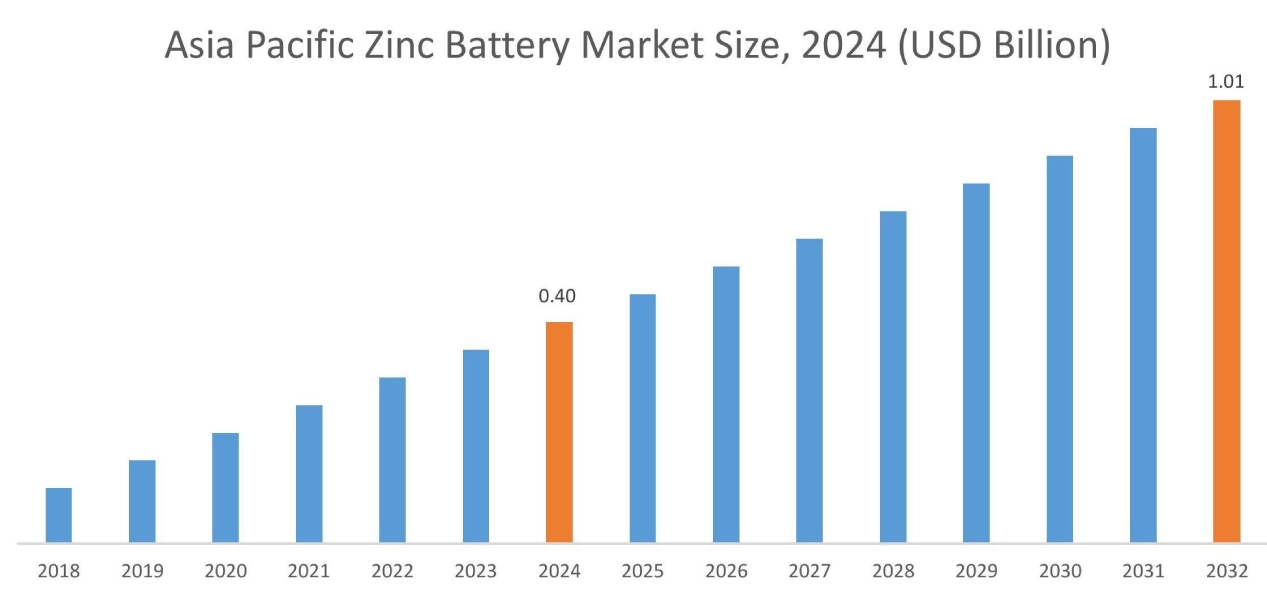
Asia Pacific region was valued at USD 0.40 Billion in 2024. Moreover, it is projected to grow by USD 0.44 Billion in 2025 and reach over USD 1.01 Billion by 2032. Out of this, China accounted for the maximum revenue share of 32.45%. The market for zinc battery is mainly driven by rapid industrialization, urbanization, and increasing size of energy industry. Additionally, rising investments in renewable energy infrastructure is further driving the market.
- For instance, in August 2024, the Jawaharlal Nehru Centre for Advanced Scientific Research (JNCASR) and Hindustan Zinc Limited (HZL)signed a memorandum of understanding to develop and commercialize indigenous zinc-ion battery technologies. The collaboration aims to create new variants of zinc materials and address existing challenges to make zinc-based batteries a viable option for India's energy storage needs.
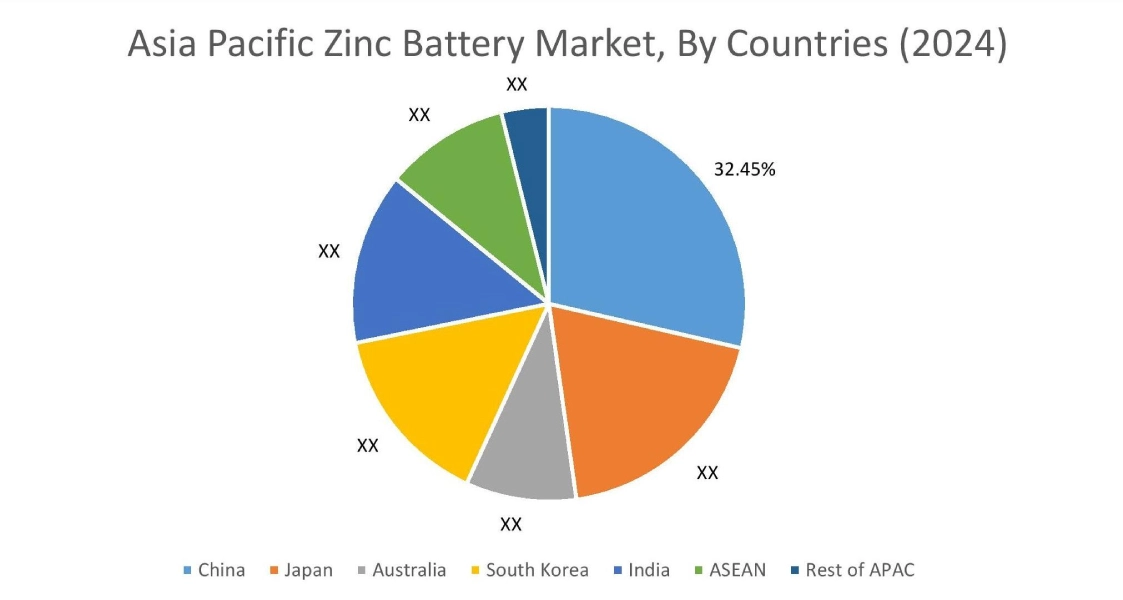
North America is estimated to reach over USD 0.34 Billion by 2032 from a value of USD 0.38 Billion in 2024 and is projected to grow by USD 0.86 Billion in 2025. The North American market is primarily driven by increasing demand for large-scale energy storage solutions to support grid modernization and renewable energy integration.
- For instance, in March 2025, Eos Energy Enterprises awarded with an USD 8 million order to supply a standalone Battery Energy Storage System (BESS) for the Naval Base of San Diego. The project is being fully funded by a grant from the California Energy Commission (CEC) and underscores Eos's role in providing American-made, zinc-based energy storage systems for U.S. national security infrastructure.
The regional analysis depicts that stringent environmental regulations and strong demand for grid-scale energy storage and electric vehicle solutions in Europe is driving the market. Additionally, factors driving the market in the Middle East and African region is increasing urbanization and growing electrification & digitalization. Further, demand for affordable and reliable energy storage solutions to support growing renewable energy projects is paving the way for the progress of market in Latin America region.
Top Key Players and Market Share Insights:
The global zinc battery market is highly competitive with major players providing solutions to the national and international markets. Key players are adopting several strategies in research and development (R&D), product innovation, and end-user launches to hold a strong position in the zinc battery industry. Key players in the global zinc battery market include-
- ZAF Energy Systems Inc(US)
- Enerpoly AB (Sweden)
- Salient Energy (Canada)
- FDK Corporation (Japan)
- ABOUND (Canada)
- ZincFive Inc.(US)
- Duracell Inc. (US)
- Energizer Holdings, Inc. (US)
- Panasonic Corporation (Japan)
- Eos Energy Enterprises Inc. (US)
Recent Industry Developments :
Partnership
In April 2024, NGK INSULATORS, LTD. started a trial of its zinc rechargeable battery cell as a backup power supply for a commercial base station operated by KDDI CORPORATION. This marks the first time a zinc rechargeable battery has been used in an operational base station in Japan. The initiative aims to enhance the base station's resilience against power outages during disasters by using a safe, large-capacity battery that has no fire risk.
Market Expansion
In September 2024, Enerpoly, a Stockholm-based innovator in zinc-ion battery technology, opened the world's first zinc-ion battery mega factory in Sweden. The facility, named the Enerpoly Production Innovation Center (EPIC), spans 6,500 square meters and is a major step in establishing Europe as a leader in this technology.
Zinc Battery Market Report Insights :
| Report Attributes | Report Details |
| Study Timeline | 2019-2032 |
| Market Size in 2032 | USD 2.85 Billion |
| CAGR (2025-2032) | 13.5% |
| By Battery Type |
|
| By Rechargeability |
|
| By Application |
|
| By Region |
|
| Key Players |
|
| North America | U.S. Canada Mexico |
| Europe | U.K. Germany France Spain Italy Russia Benelux Rest of Europe |
| APAC | China South Korea Japan India Australia ASEAN Rest of Asia-Pacific |
| Middle East and Africa | GCC Turkey South Africa Rest of MEA |
| LATAM | Brazil Argentina Chile Rest of LATAM |
| Report Coverage |
|
Key Questions Answered in the Report
How big is the zinc battery market? +
The zinc battery market is estimated to reach over USD 2.85 Billion by 2032 from a value of USD 1.15 Billion in 2024 and is projected to grow by USD 1.27 Billion in 2025, growing at a CAGR of 13.5% from 2025 to 2032.
What specific segmentation details are covered in the zinc battery report? +
The zinc battery report includes specific segmentation details for battery type, rechargeability, application, and regions.
Which is the fastest segment anticipated to impact the market growth? +
In the zinc battery market, nickel-zinc batteries is the fastest-growing segment during the forecast period.
Who are the major players in the zinc battery market? +
The key participants in the zinc battery market are ZAF Energy Systems Inc. (US), ZincFive Inc. (US), Duracell Inc. (US), Energizer Holdings, Inc. (US), Panasonic Corporation (Japan), Eos Energy Enterprises Inc. (US), Enerpoly AB (Sweden), Salient Energy (Canada), FDK Corporation (Japan), ABOUND (Canada) and others.
What are the key trends in the zinc battery market? +
The zinc battery market is being shaped by several key trends including increasing demand for sustainable and cost-effective energy storage solutions, growing adoption of electric vehicles, and significant advancements in rechargeable zinc battery technologies like zinc-ion and nickel-zinc are driving the market.
